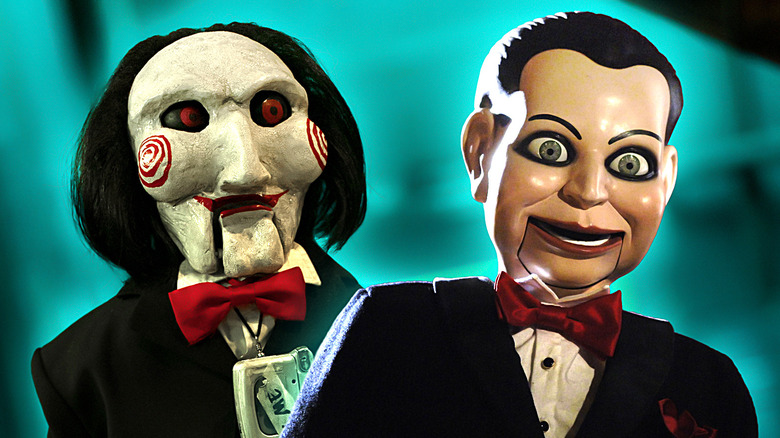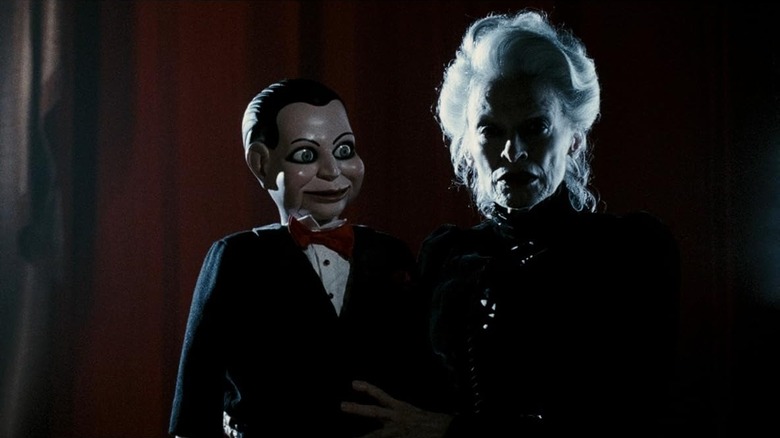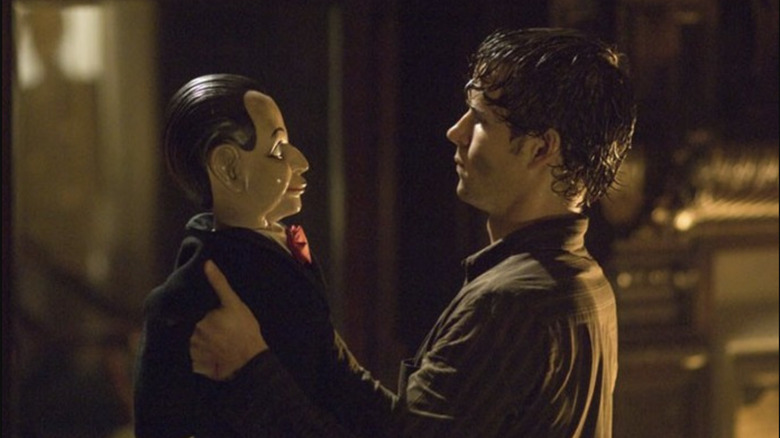James Wan's Follow-Up To Saw Was A Critical And Commercial Flop That's Now Beloved
The "sophomore slump" in art is such an assumed phenomenon that it feels almost unfairly like a prerequisite more than a common occurrence. Sure, many creatives often follow up groundbreaking debuts with efforts that don't quite reach the same level of quality and/or success, but there are far more whose follow-up album or film is just as good in its own unique way. In some cases, it takes time for these works to be fully appreciated, as the fog of hype and expectation can cloud one's judgment, of course. These factors are only heightened by the volume of opinions from audiences and critics who wish to participate in another trend that's commonly associated with follow-up films: people love to pile on what negativity they can, perhaps to prove that an artist isn't as good as they've been cracked up to be, or to humble them, or whatever psychology you'd like to attribute to the behavior.
Director James Wan and writer Leigh Whannell experienced these issues firsthand when they released their film, "Dead Silence," through Universal Pictures in March of 2007, three years after the release of their breakthrough movie "Saw." That movie was technically Wan's sophomore feature — his actual first film is 1998's "Stygian," which is still hard to find today — but it can certainly be said that it was his breakout movie, where he and Whannell were put on the horror film map. "Saw" became a massive phenomenon, earning close to 100 times its budget back while kicking off a new trend in cinematic horror that came to be known as "torture porn" (a somewhat contentious term for both Wan, Whannell, and myself, too). As a result of all this ballyhoo, the duo sought to make "Dead Silence" a totally different experience from "Saw," which failed at the box office, frustrated their new fans, and got savaged by critics upon its release. Now, however, the film has garnered the appreciation it always deserved, and it's about time.
Dead Silence almost left Wan's career dead in the water
James Wan certainly wasn't resting on his laurels in the wake of the massive success of "Saw"; as evidence, although there is a three-year gap between "Saw" and "Dead Silence," Wan also helmed the gritty Kevin Bacon-starring thriller "Death Sentence," which came out later in 2007. One would think that demonstrating his considerable range as a filmmaker by releasing two very different movies in the same calendar year would've been enough to cement Wan as a new Hollywood staple, yet some unfortunate (and unfair) common criticisms arose that nearly derailed Wan's career. For one thing, both "Dead Silence" and "Death Sentence" are unabashed genre films, utilizing the tropes and trappings of supernatural horror and action thriller, respectively, and mainstream critics tend to bristle at such violent genres to begin with, especially back during the '00s. For another, the way that the producers of "Saw" capitalized on that film's success by immediately launching a franchise ("Saw II" was ready for theaters in October of 2005) meant that some critics uncharitably believed that "Dead Silence" was merely Wan and Whannell's attempt to kickstart another IP cash cow; Scott Tobias' review for the AV Club said as much.
Wan did indeed have an agenda when making "Dead Silence," but it didn't involve trying to replicate the success of "Saw" in any way. As a matter of fact, for Wan, it was all about seeking to get as far away from "Saw" and "torture porn" as possible. As the filmmaker told The Hollywood Reporter in 2023:
"Well, 'Dead Silence,' my second movie and first studio film, was really me responding to the reaction that 'Saw' was getting, meaning that people were harping on the torture aspect of 'Saw.' So I made a very conscious decision to move away from that style of film and into something that was more of a haunted house, ghost story, which is a genre I love. But, of course, 'Saw' made such a strong impression that it carried into 'Dead Silence.' A lot of people were expecting something similar to 'Saw,' but it wasn't. Ultimately, it didn't do that well, financially, and at the time, people didn't really like it."
Wan wasn't kidding about the financial disappointment of "Dead Silence"; it was made for $20 million, and its worldwide gross just barely passed that. In addition to the film's dismal performance at the box office, there also existed some contention behind the scenes; Leigh Whannell, at least, has been vocal in the past about the way Universal meddled with the film, and such pressures must've also fallen on Wan's shoulders.
Dead Silence deserves the love and rewards your attention
During his chat with The Hollywood Reporter, Wan marveled at how his 2007 features "Dead Silence" and "Death Sentence" have both come to be appreciated in retrospect:
"But now, strangely, so many fans reach out to tell me how much they love 'Dead Silence.' And it's the same for 'Death Sentence' as well."
To be fair, even removed from the weight of post-"Saw" expectations, "Dead Silence" is a movie that grows on you more than knocks you out on first watch, and it's an effect that is nearly baked right into the film itself. To wit: the premise of "Dead Silence" implies that it's going to be a "creepy living doll" movie in the vein of "Magic" or the "Child's Play/Chucky" franchise, but just like the other doll movie Wan helped make a franchise, "Annabelle," "Dead Silence" isn't about the dolls themselves as much as it's about what (or, in this case, who) is behind them. In its story involving a mysterious small town and its sordid, evil history, "Dead Silence" most closely resembles a lost Stephen King novel, and its various setpieces are filled with Wan's keen sense of shadowplay and timing. By the time of the movie's final, Shyamalan-like twist, it's clear that we've been watching a movie that is layered enough to be even more compelling upon rewatch and rewatching a film is one of the surest ways to gain a deeper appreciation for it.
Ultimately, Wan weathered the setbacks suffered by "Dead Silence" and "Death Sentence," coming back strong with not one but two films that were great enough to bear franchise fruit: "Insidious" and "The Conjuring," meaning Wan's work includes three separate franchises that are still active today. Given the filmmaker's continued popularity and relevance, "Dead Silence" will be sure to gain more fans in the coming years as it gets rewatched and rediscovered. However, the more things change, the more they stay the same: perhaps I or someone else will be writing a similar article about Wan's last film, the unfairly maligned "Aquaman and the Lost Kingdom," some years from now.


